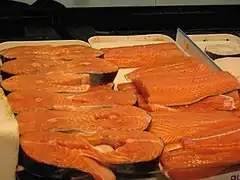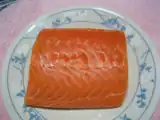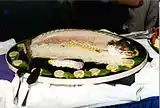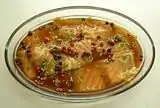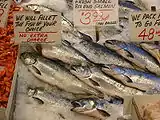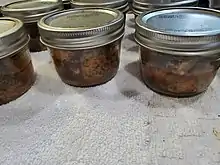Salmon as food
Salmon is a common food fish classified as an oily fish[1] with a rich content of protein and omega-3 fatty acids.[2] Norway is a major producer of farmed and wild salmon, accounting for more than 50% of global salmon production. Farmed and wild salmon differ only slightly in terms of food quality and safety, with farmed salmon having lower content of environmental contaminants, and wild salmon having higher content of omega-3 fatty acids.[2]
.jpg.webp)
Colour
| Nutritional value per 100 g (3.5 oz) | |
|---|---|
| Energy | 142 kcal (590 kJ) |
6.34 g | |
| Saturated | 1.0 g |
| Monounsaturated | 2.1 g |
| Polyunsaturated | 2.5 g 2018 mg 172 mg |
19.84 g | |
| Vitamins | Quantity %DV† |
| Vitamin A | 40 IU |
| Thiamine (B1) | 20% 0.226 mg |
| Riboflavin (B2) | 32% 0.380 mg |
| Niacin (B3) | 52% 7.860 mg |
| Pantothenic acid (B5) | 23% 1.164 mg |
| Vitamin B6 | 63% 0.818 mg |
| Folate (B9) | 6% 25 μg |
| Vitamin B12 | 133% 3.2 μg |
| Minerals | Quantity %DV† |
| Calcium | 1% 12 mg |
| Copper | 15% 0.3 mg |
| Iron | 6% 0.80 mg |
| Magnesium | 8% 29 mg |
| Phosphorus | 29% 200 mg |
| Potassium | 10% 490 mg |
| Selenium | 52% 36.5 μg |
| Sodium | 3% 44 mg |
| Zinc | 7% 0.64 mg |
| Other constituents | Quantity |
| Water | 68.50 g |
| |
| †Percentages are roughly approximated using US recommendations for adults. Source: USDA FoodData Central | |
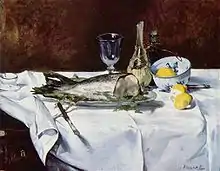
Nutrition
Raw wild salmon is 70% water, 20% protein, 6% fat, and contains no carbohydrates (table). In a 100 gram reference amount, raw salmon supplies 142 calories, and is a rich source (20% or more of the Daily Value, DV) of several B vitamins, especially vitamin B12 at 133% DV, selenium (52% DV), and phosphorus (29% DV). Dietary minerals in moderate content are copper (15% DV) and potassium (10% DV).
Contaminants
PCBs, metformin, and mercury are some of the pollutants found in wild salmon,[4] caught close to wastewater treatment plants of major metropolitan areas in the United States’ Pacific Northwest. [5]
Impact on wild populations
Some environmental groups have advocated favoring certain salmon catches over others. [6]
Products
Most Atlantic salmon available on the world market are farmed, whereas the majority of Pacific salmon are wild-caught.
Canned salmon in the U.S. is usually wild from the Pacific Ocean, though some farmed salmon is available in cans. Smoked salmon is another preparation method, and can either be hot- or cold-smoked. Lox can refer either to cold-smoked salmon or to salmon cured in a brine solution (also called gravlax). Traditional canned salmon includes some skin (which is harmless) and bone (which adds calcium). Skinless and boneless canned salmon is also available.
Raw salmon flesh may contain Anisakis nematodes, marine parasites that cause anisakiasis. Before the availability of refrigeration, Japan did not consume raw salmon. Salmon and salmon roe have only recently come into use in making sashimi (raw fish) and sushi, with the introduction of parasite-free Norwegian salmon in the late 1980s.[7]
Ordinary types of cooked salmon contain 500–1,500 mg DHA and 300–1,000 mg EPA (two similar species of fatty acids) per 100 grams[8]
Dishes
| Name | Image | Origin | Description |
|---|---|---|---|
| Dishwasher salmon | 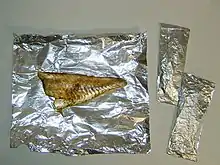 |
American | A dish made with the heat from a dishwasher. |
| Gravlax |  |
Nordic | Raw salmon cured in salt, sugar, and dill. Usually served as an appetiser, sliced thinly and accompanied by hovmästarsås (also known as gravlaxsås), a dill and mustard sauce, either on bread of some kind, or with boiled potatoes. |
| Lohikeitto | 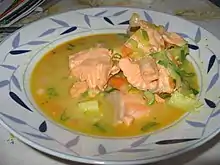 |
Nordic (usually associated with Finland) | A creamy salmon soup consisting of salmon fillets, boiled potatoes and leeks,[9][10] served hot with some dill. |
| Lomi salmon | 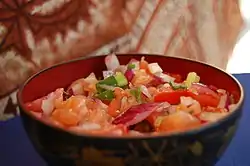 |
Polynesian | A side dish consisting of fresh tomato and salmon salad. It was introduced to Hawaiians by early western sailors.[11] It is typically prepared by mixing raw salted, diced salmon with tomatoes, sweet gentle Maui onions (or sometimes green onion), and occasionally flakes of hot red chili pepper, or crushed ice. It is always served cold. Other variations include salmon, diced tomato, diced cucumber, and chopped sweet onion. |
| Lox | 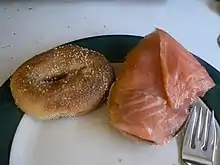 |
European (Ashkenazi) Jewish | A fillet that has been cured. In its most popular form, it is thinly sliced—less than 5 millimetres (0.2 in) in thickness—and, typically (in North America), served on a bagel, often with cream cheese, onion, tomato, cucumber and capers. Lox in small pieces is also often added and cooked into scrambled eggs, sometimes with chopped onion. |
| Rui-be | 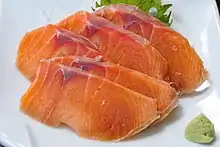 |
Japan | Salmon that is frozen outdoors, sliced like sashimi, and served with soy sauce and water peppers.[12] |
| Salmon burger | 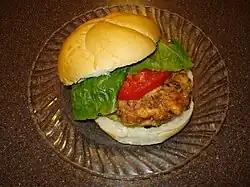 |
A type of fishcake made mostly from salmon in the style of a hamburger. It is challenging to make and cook as the salmon requires a binder to make it stick together and is easy to overcook which makes it too dry.[13] Salmon burgers are especially common in Alaska where they are routinely offered as an alternative to beef hamburgers.[14] | |
| Salmon tartare |  |
Appetiser prepared with fresh raw salmon and seasonings, commonly spread on a cracker or artisan style bread | |
| Smoked salmon |  |
A preparation of salmon, typically a fillet that has been cured and then hot or cold smoked. Due to its moderately high price, smoked salmon is considered a delicacy. Although the term lox is sometimes applied to smoked salmon, they are different products.[15] | |
| Salmon sashimi |  |
Japan | Sliced raw salmon served with garnishes. Usually eaten by dipping in soy sauce and wasabi. |
| Salmon sushi |  |
Norway,[16] Japan | Sliced raw salmon rolled with rice and sometimes nori (seaweed) as makizushi or placed on top of rice as nigiri sushi, served with garnishes. Usually eaten by dipping in soy sauce and wasabi. |
| Kippered salmon | Hupa, Karuk, Yurok | Salmon smoked using fruitwood until cooked on the outside but raw on the inside, then canned and pressure cooked. Can be seasoned with red pepper and other seasonings. |
Gallery
| Further images |
|---|
|
See also
Notes
- "What's an oily fish?". Food Standards Agency. 24 June 2004. Archived from the original on 18 December 2010.
- Elise Kjørstad (English translation by Ingrid P. Nuse) (22 December 2017). "How healthy is farmed salmon?". Sciencenorway.no. Retrieved 19 November 2022.
- "Opinion of the Scientific Committee on Animal Nutrition on the use of canthaxanthin in feedingstuffs for salmon and trout, laying hens, and other poultry" (PDF). European Commission — Health & Consumer Protection Directorate. pp. 6–7. Retrieved 19 November 2022.
- Anne-Katrine Lundebye (24 March 2017). "More environmental pollutants in wild salmon than in farmed salmon". Institute of Marine Research, Norway. Retrieved 10 June 2019.
- Meador, James P.; Yeh, Andrew; Young, Graham; Gallagher, Evan P. (2016). "Contaminants of emerging concern in a large temperate estuary". Environmental Pollution. 213: 254–267. doi:10.1016/j.envpol.2016.01.088. ISSN 0269-7491. PMC 5509463. PMID 26907702.
- Click on View details for wild impacts – "Salmon: All Recommendations for Salmon". Seafood Watch, Monterey Bay Aquarium, California. 2019. Retrieved 10 June 2019.
- Jiang, Jess (18 September 2015). "How The Desperate Norwegian Salmon Industry Created A Sushi Staple". National Public Radio. Archived from the original on 24 April 2019. Retrieved 14 January 2017.
- "Addendum A: EPA and DHA Content of Fish Species". Office of Disease Prevention and Health Promotion, Office of the Assistant Secretary for Health, Office of the Secretary, U.S. Department of Health and Human Services. USDA. Archived from the original on 8 April 2019. Retrieved 2 May 2019.
- Ojakangas, Beatrice A (1992). Scandinavian feasts: celebrating traditions throughout the year. U. of Minnesota Press. p. 220.
- Davidson, Alan. North Atlantic Seafood: A Comprehensive Guide with Recipes. Ten Speed Press. p. 360.
- "Polynesian Cultural Center: Hawaiian Luau Food". Archived from the original on 16 December 2009. Retrieved 19 July 2009.
- Chris Rowthorn (1 October 2009). Japan. Lonely Planet. pp. 582–. ISBN 978-1-74179-042-9. Retrieved 26 May 2012.
- Mark Bittman (10 June 1998). "The Minimalist; Burger With No Need of Ketchup". The New York Times. Archived from the original on 11 May 2009.
- Jim DuFresne; Greg Benchwick; Catherine Bodry (2009), Alaska, ISBN 978-1-74104-762-2
- Kinetz, Erika (22 September 2002). "So Pink, So New York". The New York Times. Archived from the original on 4 October 2010. Retrieved 9 December 2007.
- "Norway's Introduction of Salmon Sushi to Japan". Archived from the original on 30 March 2013. Retrieved 16 January 2017.
Further reading
- Come back, salmon, By Molly Cone, Sierra Club Books, 48 pages, ISBN 0-87156-572-2 - A book for juveniles describes the restoration of 'Pigeon Creek'.
- The salmon: their fight for survival, By Anthony Netboy, 1973, Houghton Mifflin Co., 613 pages, ISBN 0-395-14013-7
- Trading Tails: Linkages Between Russian Salmon Fisheries and East Asian Markets. Shelley Clarke. (November 2007). 120pp. ISBN 978-1-85850-230-4.
- "Last Stand of the American Salmon," G. Bruce Knecht for Men's Journal
